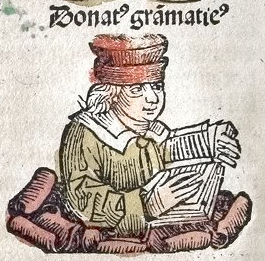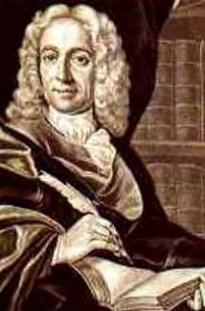
Priscianus Caesariensis, commonly known as Priscian, was a Latin grammarian and the author of the Institutes of Grammar, which was the standard textbook for the study of Latin during the Middle Ages. It also provided the raw material for the field of speculative grammar.
This article contains information about the literary events and publications of 1632.

Aelius Donatus was a Roman grammarian and teacher of rhetoric.

John Davies, Mallwyd was one of Wales's leading scholars of the late Renaissance. He wrote a Welsh grammar and dictionary. He was also a translator and editor and an ordained minister of the Church of England.

Matthias Bel or Matthias Bél was a Lutheran pastor and polymath from the Kingdom of Hungary. Bel was active in the fields of pedagogy, philosophy, philology, history, and theoretical theology; he was the founder of Hungarian geographic science and a pioneer of descriptive ethnography and economy. A leading figure in pietism. He is also known as the Great Ornament of Hungary.
Diego Collado was a Spanish Christian missionary. He was born at Miajadas, in the province of Extremadura, Spain. He entered the Dominican Order at San Esteban, Salamanca around 1600, and in 1619 went to Japan. As Christianity had already been formally outlawed by Tokugawa Ieyasu in 1614, Collado spent his time in hiding, frequently changing residences to avoid being arrested. He traveled the country, learning Japanese and proselytizing to the local population, until he was recalled to Europe in 1622. He spent the next decade challenging the monopoly of the Jesuits in ministering to Japan, and his account of the venal behavior he observed in Japan was cited by Thomas Gage, a former Dominican friar turned Protestant, as evidence of Jesuit malpractice and the conflict between Dominicans and Jesuits.

Manuel Álvares was a Jesuit educator in Portugal.
An ars grammatica is a generic or proper title for surveys of Latin grammar. The first ars grammatica seems to have been composed by Remmius Palaemon, but is now lost. The most famous ars grammatica since late antiquity has been that composed by Donatus.

Samuil Micu Klein was a Romanian Greek-Catholic theologian, historian, philologist and philosopher, a member of the Enlightenment-era movement of Transylvanian School. He is the author of Elementa linguae daco-romanae sive valachicae, a book which is the reference point for the start of Modern Romanian language period.

Francisco Sánchez de las Brozas (1523–1600), also known as El Brocense, and in Latin as Franciscus Sanctius Brocensis, was a Spanish philologist and humanist.

Franciscus à Mesgnien Meninski (1623–1698) was the author of a multi-volume Turkish-to-Latin dictionary and grammar of the Turkish language, first published in 1680, which was ground-breaking in its comprehensiveness at the time, and for historians and linguists today it is a valuable reference for the Turkish language of the early modern period.
Siôn Dafydd Rhys, in Latin Joannes David Rhaesus, also called John David Rhys, or John Davies, was a Welsh physician and grammarian. He wrote the first Welsh grammar in Latin, published in 1592.
Æschillus (Eskil) Petræus was Bishop of Turku in 1652–1657.
Simon Verepaeus or Verrept was a priest and educator in the 16th-century Habsburg Netherlands, whose works on prayer, Latin grammar, and Latin composition continued to be reprinted until the early 19th century.
Thomas Wiliems was a Welsh-language antiquarian.
Diego Collado may refer to:

Compendium Grammaticæ Lithvanicæ is a prescriptive printed grammar of the Lithuanian language, which was one of the first attempts to standardize the Lithuanian language. The grammar was intended for pastors who knew little or no Lithuanian so that they could learn the language and communicate with their Lithuanian-speaking parishioners.
The Excerptiones Prisciani is a tenth-century compilation of Priscian's Institutiones grammaticae and Donatus's Ars maior.
A grammar book is a book or treatise describing the grammar of one or more languages. Such books are themselves frequently referred to as grammars.
This page is based on this
Wikipedia article Text is available under the
CC BY-SA 4.0 license; additional terms may apply.
Images, videos and audio are available under their respective licenses.








